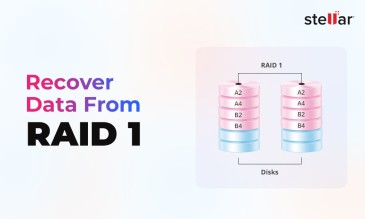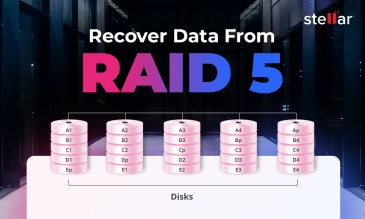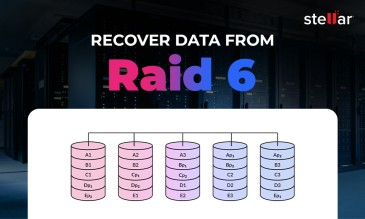Summary:
- RAID 10 offers fast, fault-tolerant storage by combining mirroring and striping. But data loss can still occur in RAID 10, for instance, if both drives in a mirrored pair fail.
- Warning signs of impending RAID 10 failure are degraded arrays, repeated disk errors, or inaccessible volumes.
- Most RAID 10 crashes involve dual drive failure in one pair, controller issues, ransomware attacks, or accidental deletion and corruption.
- RAID 10 recovery is only possible if at least one disk survives per mirrored pair and the correct configuration is known.
- DIY attempts are risky, so it’s better to trust a professional RAID data recovery service for safe, complete recovery.
Introduction to RAID 10 Data Recovery
Most IT teams depend on RAID-configured arrays for business-critical storage. In fact, if you're managing enterprise-grade workloads, chances are you are familiar with, or already using, RAID 10.
But what happens when even a robust array like RAID 10 fails? And if the data stored therein is invaluable, what is the best response strategy?
At Stellar, we’ve seen almost every possible RAID 10 failure and recovered data from RAID 10-configured servers for banks, hospitals, SaaS firms, and others.
This blog explains all you need to know about data recovery from RAID 10.
Why So Many Critical Systems Use RAID 10
Let’s start with the basics.
The core idea of RAID (full form: Redundant Array of Independent Disks) is to make several drives work together so you get more storage, faster I/O, or better reliability than any single drive could give.
And because it promises the holy grail of RAID-based storage—both safety and speed—RAID 10 (also written as RAID 1+0) is typically used for mission-critical servers, clustered databases, high-frequency trading, and even high-transaction e-commerce sites.
So, What Sets RAID 10 apart?
RAID 10 is unique in the sense that it executes a “striped mirror” of drives. This means:
- You pair up disks so that every bit of data is written to two drives (mirroring, or RAID 1).
- Then, you take those pairs and stripe data across them (striping, or RAID 0).
So, in a way, RAID 10 means RAID 1 + RAID 0.
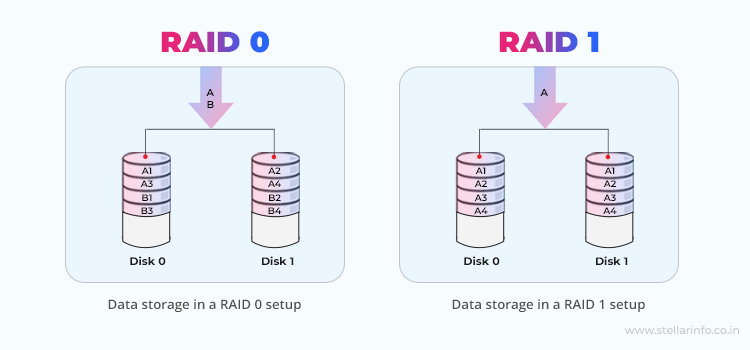
This gives you the speed of RAID 0 and the redundancy of RAID 1, all in one. What you get is RAID 1+0, or RAID 10, as it’s more commonly known.
So, when your business runs on Oracle, SQL, VMware, SAP, or any app that demands performance and uptime, RAID 10 is the obvious choice.
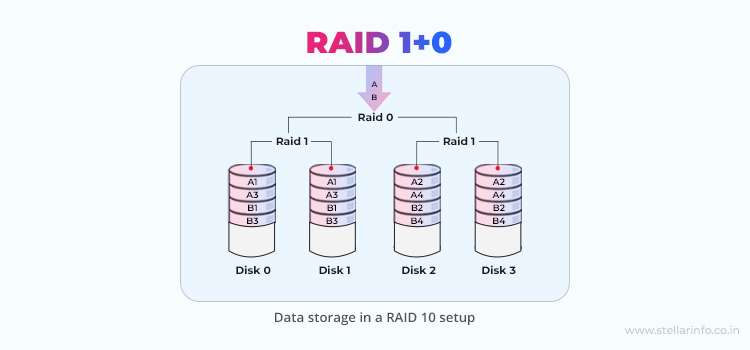
But here’s the catch: all that resilience has its price. You lose half your storage to mirroring, and when things do go wrong, recovery isn’t always straightforward.
Common RAID 10 Failure Scenarios
With RAID 10, if a single drive fails, the mirrored pair quietly takes over and the array keeps working. But what if two disks fail? That’s where things get complicated (and risky).
A RAID 10 array can handle multiple failures, but only if they happen in different mirrored pairs.
So, in a situation where you lose both drives from the same pair (it happens more often than you’d think, especially if you delay replacements or drives are from the same batch), that entire chunk of your data is gone.
Here are some other scenarios where a RAID 10 array can fail.
- Controller failure (suddenly the entire array is offline, even though disks are fine).
- Power surges that take out multiple drives at once.
- Human error: incorrect rebuilding attempts; accidental initialization or disk swapping.
- File system corruption, malware infection, or mass deletions, where the disks are healthy, but the data is scrambled or missing.
- Natural disasters (floods, fires, overheating) that physically damage the array.
Bottom line: RAID 10’s “mirrored stripe” design can survive a lot of disruption, but not everything. The most painful cases of RAID 10 failure are those where we see two disks lost from the same mirrored pair. When this happens, the array stops, and data recovery is very complicated.
Can You Recover Data From RAID 10?
You might have heard, “RAID 10 is easy to recover. Just re-mirror it.” That’s true in cases where you lose only one disk per pair, and you detect this loss in time. In such cases, you can swap the failed disk with a new one, and the controller will do the rest.
But in the real world, RAID failures are more complex. Here are some RAID 10 failure scenarios we see quite often.
- Admins didn’t notice a failed disk, and then its mirror failed too.
- The controller crashed and took the configuration metadata with it.
- Someone pulled the wrong disk or started a rebuild with the wrong member.
- There’s a logical corruption, not a simple hardware issue.
And here’s why things get even more complicated when we try to recover data from RAID 10.
- RAID 10 data recovery only works if you have at least one healthy disk from each mirrored pair.
- If both drives from a mirror are dead, that data is gone; there is no parity logic, and hence no safety net.
- If you mix up the order of disks or stripe size during DIY recovery, you can scramble your files.
- Some controllers (Dell, HP, Lenovo, Synology, QNAP, NetApp, and some others) use proprietary layouts or metadata. If it’s lost, you have to reverse-engineer the entire structure.
So yes, RAID 10 data recovery is possible when you have the right drives and the technical know-how. If not, recovering data from RAID 10 can become a technical mess only a specialist can solve.
RAID 10 Data Recovery Process: How Professionals Get Your Data Back
At Stellar, we’ve built our reputation on successfully recovering RAID 10 data where others can’t. Here is the approach that makes us the most reliable data recovery service for RAID configurations such as RAID 10.
- The first rule is to stop operating a broken RAID 10 immediately. For every minute your failed RAID keeps on serving data, the possibility of complete failure and permanent loss increases. So, we advise our readers to immediately power off the array, label the drives in order, and avoid any further writes.
- We clone each disk sector by sector (using special hardware write-blockers) before we touch anything. If a drive is damaged, it goes straight to our Class 100 cleanroom. Why? Because we only get one chance to recover data correctly. Working on the original disks risks destroying unique data, and we eliminate this risk during the cloning process.
- We figure out which drives form mirrored pairs, what the stripe size is, and the order of the sets. If controller metadata is lost, we can still use our proprietary tools and experience to compare drive contents, look for filesystem markers, and map out the original layout.
- Using the cloned images, we build a “virtual” RAID 10. We double-check to make sure files open, directories make sense, and there’s no silent corruption.
- Once the virtual RAID is up, we copy your files out to safe storage. We check everything, especially mission-critical databases, VMs, and documents.
- If you’re thinking that this sounds intense, that’s because it is. But every step is important, as it helps us avoid irreversible loss and ensures you get back as much data as possible.
Can DIY RAID 10 Recovery Be Attempted?
You might be tempted to try a DIY RAID 10 data recovery tool or follow a forum/guide on RAID 10 data recovery. However, we have seen DIY data recoveries go wrong, over and over.
- If you force a failed drive back online or attempt a rebuild with a lagging or out-of-sync disk, you run the risk of corrupting the entire array.
- Unlike RAID 5/6, there’s no parity to help you reconstruct lost data if both disks in a RAID 10 mirror are gone.
- You could be tempted to use consumer-grade data recovery software, which doesn’t account for controller-specific layouts, nor does it handle drives with hardware errors.
- If you swap or initialize the wrong disk, you will overwrite good data with bad or empty sectors.
- If you run utilities like CHKDSK on a degraded or misassembled array, the file corruption will become worse.
And don’t forget: every minute you run the array in a degraded state, your chances of total loss go up.
So, if your business data matters, pause and consult RAID data recovery experts. The sooner you get in touch, the better your chances of successful recovery.
Why So Many Trust Stellar for RAID 10 Recovery
At Stellar, we’ve recovered RAID 10, NAS, SAN, and server data for nearly every brand and scenario: Dell, HP, Lenovo, Synology, QNAP, NetApp, and many more.
Why Choose Stellar?
- Our engineers know how to handle every RAID type and vendor, even if it’s a complex hybrid array.
- We have the infrastructure to repair and image even physically damaged drives in Class 100 environments.
- We never work on original drives (only on clones). This is your best insurance against further loss.
- Since 1993, we’ve solved RAID data recovery cases for banks, hospitals, SaaS providers, cloud platforms, and critical government infrastructure.
- Our RAID recovery centers are located across the country—just search for “data recovery near me on the internet,” and you’ll find the nearest one.
- We offer quick evaluations, fixed quotes, and follow strict chain-of-custody protocols for your data’s security.
A Word of Advice
It’s clear that RAID 10 is a viable choice for business-critical storage, but it’s not completely fail-safe.
Whenever you face a RAID 10 failure, don’t panic and don’t try risky DIY fixes. You have to use the right approach the first time to get the best shot at a complete recovery.
If you need help now or just want professional advice, contact Stellar. When it comes to RAID 10 data recovery, we’re the trusted partner for IT teams and business leaders who can’t afford to gamble with their data.
If you’re facing data loss from a different RAID setup, the following guides might help you recover your data effectively:
FAQs
To recover data from a RAID 10 array, the first step is to power down the server to prevent further damage. Then, contact a professional RAID recovery service so that they can clone each disk, analyze the RAID configuration (mirrored pairs and stripe size), and then virtually reconstruct the array using specialized tools.
RAID 10 is more fault tolerant compared to many other configurations. It can survive multiple disk failures, but only if those failures occur in different mirrored pairs. The array will continue operating as long as at least one disk survives in each pair. However, if both disks in a mirror set fail, the data from that set is lost, and the whole array can go offline.
DIY RAID server data recovery is extremely risky, as you might overwrite good data, misconfigure the array, or worsen physical damage to drives. If your data is critical, always trust certified RAID data recovery experts for the best chance of complete recovery.
About The Author

Data Recovery Expert & Content Strategist






